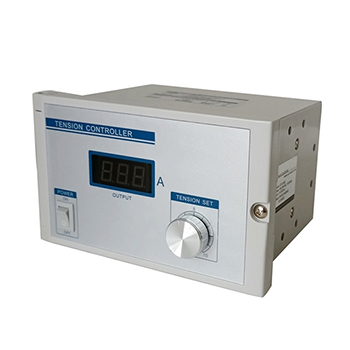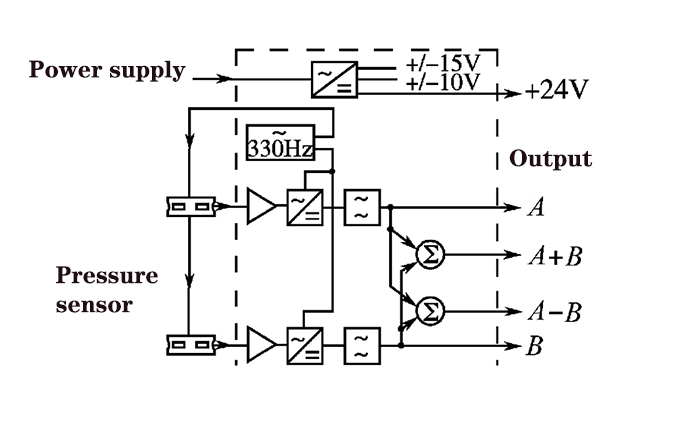What is the Use of Tension Controller?
The tension controller is a kind of control instrument, which can directly set the tension value required to be controlled, and then input the signal of the tension sensor (generally at the millivolt level) as the tension feedback value. After the deviation is obtained by comparison, it is input to the PID and other controls. Processed by the controller, it is best to output to the peripheral actuator for control, and finally achieve the goal of the smallest deviation and the fastest system response.
Use of tension controller
The essence of constant tension control with a frequency converter is dead loop vector control, adding encoder feedback. For winding, the winding warp changes from small to large. In order to ensure constant tension, the output torque of the motor is required to change from small to large. At the same time, in different operation processes, corresponding torque compensation should be carried out. That is to say, at the moment when the small roll is started, accelerated, decelerated, or stopped, and when the large roll is started, different torque compensations should be performed at different warps, so that the whole process of winding can be stabilized and the tension of the small roll can be avoided and yarn loosening phenomenon when large roll starts.
To provide power for the magnetic powder clutch/brake, the torque of the magnetic powder clutch/brake can be adjusted by adjusting the output current.
To protect the magnetic powder clutch/brake. The output current of the tension controller is 0-4A, so if the working current is a magnetic powder clutch of 1A. The tension controller is directly adjusted to the maximum by accident, and the magnetic powder clutch will not burn out. Because when you adjust the output current of the tension controller to the maximum, the tension controller will automatically adapt to the maximum operating current of the magnetic powder clutch after 3 seconds, thereby protecting the magnetic powder clutch/brake.
PLC can be connected externally, and the manual control tension controller can manually adjust the output current. If you have a PLC system, you can connect externally to the PLC system to achieve a semi-automatic effect.
Application industry
Paper, plastic, textile, cable, packaging, and other industries.
Working principle
Coil static magnetic powder clutch and magnetic powder brake are automatic devices that control the input current to change the output torque. When the coil is not energized, the input shaft rotates, and the magnetic powder is attached to the inner wall of the clamp ring under the action of centrifugal force. The output shaft and the input shaft are not in contact, and it is in an idling state at this time.
When the coil is energized, the magnetic powder will generate a flux linkage under the action of the magnetic force line, so that the output shaft and the input shaft will rotate as a whole, and slip will be generated when overloaded. At this time, it is in the working state, so as to achieve the purpose of torque transmission.
Usually, in order to ensure the speed of the machine, a tension controller is often used to control the running speed of the machine. This control must be effective for any operating speed of the machine, including acceleration, deceleration, and constant speed of the machine. Even in the case of mechanical emergency braking, it should be able to ensure that the cut object is not damaged. The stability of tension control is directly related to the quality of cutting products. If the tension is insufficient, the raw material will drift during operation, and the finished paper will wrinkle after slitting and rewinding.
The digital tension controller adjusts the excitation current of the magnetic powder clutch or magnetic powder brake manually on the controller according to the change of the winding diameter of the rewinding and unwinding tube, so as to ensure that the tension of the product is relatively constant.
The automatic tension controller directly detects the tension through the sensor and automatically adjusts the excitation current of the clutch or brake according to the set target tension and the measured tension to control the tension of the coil material to achieve tension.
Classification
The tension controller can manually or automatically adjust the tension of the product so that the tension change can be effectively controlled. The tension controller is mainly used in tension systems where the actuator is a magnetic powder clutch or a magnetic powder brake. There are three modes: manual, semi-automatic, and automatic.
- Manual tension controller type: When unwinding, rewinding control or intermediate shaft control with small changes in roll diameter, the tension controller performs manual control using magnetic powder brakes and magnetic powder clutches; when the machine stops, it performs emergency control or is running during the process to adjust the knob travel operation.
- Semi-automatic control type: detect the roll diameter in a non-contact way, and control the unwinding braking torque or winding torque accordingly.
- Fully automatic control type: a closed-loop tension controller is used, and multi-axis switching control is performed according to an external sequence control program. This type of tension controller must perform pre-drive control externally and has the permanent ability to control the tension of the material belt conveyed on the equipment and ensure that the material belt will not be damaged at all. It is usually used in conjunction with transmission equipment such as magnetic powder brakes and magnetic powder clutches.
What is tension control?
The so-called tension control, in layman's terms, is to be able to control how much force the motor outputs, that is, how many Newtons it outputs. The output torque of the motor can be controlled by reacting to the motor shaft. The real tension control is different from the tension system formed by the speed difference between the front and rear power points. The essence of adjusting the tension by the speed difference is the PID control of the tension, and a tension sensor is required. Moreover, it is impossible to achieve the effect of real tension control when the large and small rolls are started, stopped, accelerated, decelerated, and stopped, and the tension is not very stable. It will definitely affect the quality of the products produced.

